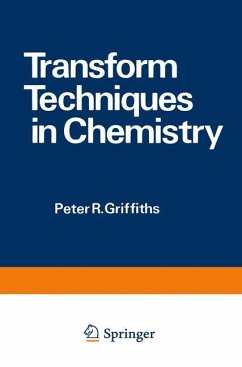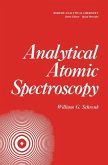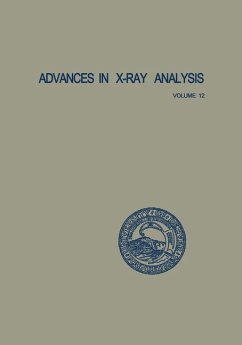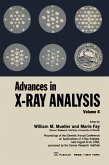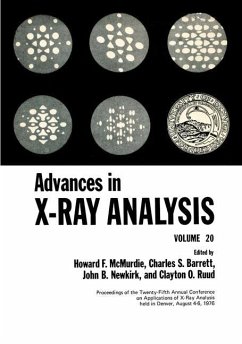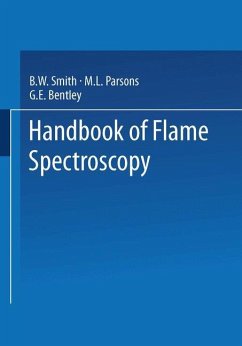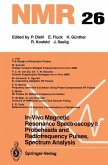Transform Techniques in Chemistry
Herausgegeben von Griffiths, P.
Transform Techniques in Chemistry
Herausgegeben von Griffiths, P.
- Broschiertes Buch
- Merkliste
- Auf die Merkliste
- Bewerten Bewerten
- Teilen
- Produkt teilen
- Produkterinnerung
- Produkterinnerung
The application of the Fourier transform is being seen to an increasing extent in all branches of chemistry, but it is in the area of chemical analysis that the greatest activity is taking place. Fourier transform infrared and nuclear magnetic resonance spectrometry are already routine methods for obtaining high-sensitivity IR and NMR spectra. Analogous methods are now being developed for mass spectrometry (Fourier transform ion cyclo tron resonance spectrometry) and microwave spectroscopy, and Fourier transform techniques have been successfully applied in several areas of electrochemistry. In…mehr
Andere Kunden interessierten sich auch für
![Analytical Atomic Spectroscopy Analytical Atomic Spectroscopy]() William SchrenkAnalytical Atomic Spectroscopy100,99 €
William SchrenkAnalytical Atomic Spectroscopy100,99 €![Advances in X-Ray Analysis Advances in X-Ray Analysis]() Charles S. BarrettAdvances in X-Ray Analysis42,99 €
Charles S. BarrettAdvances in X-Ray Analysis42,99 €![Advances in X-Ray Analysis Advances in X-Ray Analysis]() William M. MuellerAdvances in X-Ray Analysis41,99 €
William M. MuellerAdvances in X-Ray Analysis41,99 €![Advances in X-ray Analysis Advances in X-ray Analysis]() Advances in X-ray Analysis43,99 €
Advances in X-ray Analysis43,99 €![Handbook of Flame Spectroscopy Handbook of Flame Spectroscopy]() B. SmithHandbook of Flame Spectroscopy42,99 €
B. SmithHandbook of Flame Spectroscopy42,99 €![Chemical Analysis of the Environment and Other Modern Techniques Chemical Analysis of the Environment and Other Modern Techniques]() Chemical Analysis of the Environment and Other Modern Techniques42,99 €
Chemical Analysis of the Environment and Other Modern Techniques42,99 €![In-Vivo Magnetic Resonance Spectroscopy I: Probeheads and Radiofrequency Pulses Spectrum Analysis In-Vivo Magnetic Resonance Spectroscopy I: Probeheads and Radiofrequency Pulses Spectrum Analysis]() In-Vivo Magnetic Resonance Spectroscopy I: Probeheads and Radiofrequency Pulses Spectrum Analysis125,99 €
In-Vivo Magnetic Resonance Spectroscopy I: Probeheads and Radiofrequency Pulses Spectrum Analysis125,99 €-
-
-
The application of the Fourier transform is being seen to an increasing extent in all branches of chemistry, but it is in the area of chemical analysis that the greatest activity is taking place. Fourier transform infrared and nuclear magnetic resonance spectrometry are already routine methods for obtaining high-sensitivity IR and NMR spectra. Analogous methods are now being developed for mass spectrometry (Fourier transform ion cyclo tron resonance spectrometry) and microwave spectroscopy, and Fourier transform techniques have been successfully applied in several areas of electrochemistry. In addition the fast Fourier transform algorithm has been used for smoothing, interpolation, and more efficient storage of data, and has been studied as a potential method for more efficient identification of samples using pattern recognition techniques. Linear transforms have also been shown to be useful in analytical chemistry. Probably the most important of these is the Hadamard transform, which has been applied in alternative methods for obtaining IR and NMR data at high sensitivity. Even though measurements involving this algorithm will probably not be applied as universally as their Fourier transform ana logs, in the area of pattern recognition application of the Hadamard trans form will in all probability prove more important than application of the Fourier transform.
Hinweis: Dieser Artikel kann nur an eine deutsche Lieferadresse ausgeliefert werden.
Hinweis: Dieser Artikel kann nur an eine deutsche Lieferadresse ausgeliefert werden.
Produktdetails
- Produktdetails
- Modern Analytical Chemistry
- Verlag: Springer / Springer US / Springer, Berlin
- Artikelnr. des Verlages: 978-1-4684-2405-8
- Softcover reprint of the original 1st ed. 1978
- Seitenzahl: 404
- Erscheinungstermin: 12. Dezember 2012
- Englisch
- Abmessung: 229mm x 152mm x 22mm
- Gewicht: 583g
- ISBN-13: 9781468424058
- ISBN-10: 146842405X
- Artikelnr.: 37480539
- Herstellerkennzeichnung
- Books on Demand GmbH
- In de Tarpen 42
- 22848 Norderstedt
- info@bod.de
- 040 53433511
- Modern Analytical Chemistry
- Verlag: Springer / Springer US / Springer, Berlin
- Artikelnr. des Verlages: 978-1-4684-2405-8
- Softcover reprint of the original 1st ed. 1978
- Seitenzahl: 404
- Erscheinungstermin: 12. Dezember 2012
- Englisch
- Abmessung: 229mm x 152mm x 22mm
- Gewicht: 583g
- ISBN-13: 9781468424058
- ISBN-10: 146842405X
- Artikelnr.: 37480539
- Herstellerkennzeichnung
- Books on Demand GmbH
- In de Tarpen 42
- 22848 Norderstedt
- info@bod.de
- 040 53433511
1 Transform Techniques in Chemistry: Past, Present, and Future.- 1.1. The Past.- 1.2. The Present.- 1.3. The Future.- 2 The Fourier Transform and Related Concepts: A First Look.- 2.1. Introduction: Guitar Tuning.- 2.2. Differences in Space and Time: Phase.- 2.3. Sums, Integrals, and Orthogonality.- 2.4. Various Expressions of Fourier Transform Relationships.- 2.5. Concepts and Corollaries for Fourier Transforms.- 2.6. More on Phase and Phase Correction.- 2.7. Apodization and Resolution Enhancement.- 2.8. The Discrete Fourier Transform.- 2.9. Walsh and Hadamard Transforms.- 2.10. Summary.- 3 Multichannel Methods in Spectroscopy.- 3.1. Introduction.- 3.2. Spectrometer Sources and Detectors.- 3.3. Weights on a Balance: The Multichannel Advantage. Multiplex Methods.- 3.4. Hadamard Multiplexing of Spatially Dispersed Spectra.- 3.5. Advantages of Coherent Radiation in Spectrometer Detection.- 3.6. Fourier Methods.- 3.7. Summary: Relations Between Different Spectrometers.- 3.8. Appendix. Noise Considerations for Multichannel Spectrometers.- 4 Data Handling in Fourier Transform Spectroscopy.- 4.1. The Computer System.- 4.2. The Fourier Transform.- 4.3. Writing a Fourier Transform for a Minicomputer.- 4.4. Noise in the Fourier Transform Process.- 4.5. Summary.- 5 Fourier Transform Infrared Spectrometry: Theory and Instrumentation.- 5.1. Introduction.- 5.2. The Michelson Interferometer.- 5.3. Resolution and Apodization.- 5.4. Effect of Beam Divergence.- 5.5. Mirror Drive Tolerance.- 5.6. Dynamic Range.- 5.7. Scan Speed and Spectral Modulation.- 5.8. Data Acquisition.- 5.9. Beamsplitters.- 5.10. Lamellar Grating Interferometers.- 5.11. Detectors for FT-IR.- 5.12. Auxiliary Optics.- 5.13. Data Systems.- 5.14. Dual-Beam Fourier Transform Spectroscopy.- 6 Infrared Fourier Transform Spectrometry: Applications to Analytical Chemistry.- 6.1. FT-IR versus Grating Spectrophotometers.- 6.2. Spectra of Transient Species.- 6.3. Low-Energy Absorption Spectrometry.- 6.4. Difference Spectroscopy.- 6.5. Reflection Spectrometry.- 6.6. Emission Spectrometry.- 6.7. Atomic Spectrometry.- 7 Hadamard Transform Analytical Systems.- 7.1. Introduction.- 7.2. Weighing Designs and Optical Multiplexing.- 7.3. Historical Background of Multiplexing by Means of Masks.- 7.4. Mathematical Development.- 7.5. Varieties of Encoded Spectrometers.- 7.6. Limitations: HTS Instruments and Interferometers.- 7.7. Imagers and Spectrometric Imagers.- 7.8. Signal and Noise Limitations.- 7.9. Special Optical Systems.- 7.10. Some Future Applications.- 8 Pulsed and Fourier Transform NMR Spectroscopy.- 8.1. Introduction.- 8.2. Basic Concepts of FT-NMR.- 8.3. Basic Instrumentation.- 8.4. Recent Instrumental Improvements.- 9 Advanced Techniques in Fourier Transform NMR.- 9.1. Introduction.- 9.2. Systematic Noise Reduction.- 9.2.1. Noise Reduction Methods.- 9.2.2. Relaxation Times and Spin Echoes.- 9.3. Sideband Filters and Quadrature Detection NMR.- 9.4. Rapid-Scan (Correlation) NMR.- 9.5. Noise Excitation Methods.- 9.6. Measure of the Spin-Lattice Relaxation Time T1.- 9.7. Techniques for the Suppression of Strong Solvent Peaks.- 10 Fourier Transform Ion Cyclotron Resonance Spectroscopy.- 10.1. Introduction.- 10.2. Fundamental Equations for ICR Linewidth and Resolution.- 10.3. Fourier Transform Ion Cyclotron Resonance (FT-ICR) Spectroscopy.- 10.4. Analytical FT-ICR Linewidth and Mass Resolution.- 10.5. FT-ICR Mass Range, Computer Data Size, and Sampling Rate.- 10.6. Discussion.- 11 Fourier Domain Processing of General Data Arrays.- 11.1. Introduction.- 11.2. Fourier Transformation and a GeneralData Array.- 11.3. Amplitude and Phase Arrays.- 11.4. Transformation as a Reversible Operation.- 11.5. Specific Manipulations of Data in the Fourier Domain.- 11.6. Summary.- 12 Fourier and Hadamard Transforms in Pattern Recognition.- 12.1. Introduction.- 12.2. Binary Pattern Classifiers.- 12.3. Fourier and Hadamard Transforms in Pattern Recognition.- 12.4. Conclusions.- 13 Spectral Representations for Quantized Chemical Signals.- 13.1. Introduction.- 13.2. 13C FID Signals and Their Spectra.- 13.3. Orthogonal Expansions and Spectral Representations.- 13.4. Clipped Signals and Their Spectral Representations.- 13.5. Random Real-Zero Signals.- 13.6. Zero-Based Product Representations for Band-Limited Signals.- 13.7. Spectra of Clipped FID Signals.- 13.8. Summary, Implications, and Open Questions.- 14 Applications of the FFT in Electrochemistry.- 14.1. Introduction.- 14.2. Faradaic Admittance Measurements-Basic Principles.- 14.3. Instrumentation.- 14.4. Kinetics of Electrode Processes.- 14.5. Relevant Properties of the FFT for Electrochemical Relaxation Measurements.- 14.6. Published and Future Applications of the FFT in Electrochemistry.- References.
1 Transform Techniques in Chemistry: Past, Present, and Future.- 1.1. The Past.- 1.2. The Present.- 1.3. The Future.- 2 The Fourier Transform and Related Concepts: A First Look.- 2.1. Introduction: Guitar Tuning.- 2.2. Differences in Space and Time: Phase.- 2.3. Sums, Integrals, and Orthogonality.- 2.4. Various Expressions of Fourier Transform Relationships.- 2.5. Concepts and Corollaries for Fourier Transforms.- 2.6. More on Phase and Phase Correction.- 2.7. Apodization and Resolution Enhancement.- 2.8. The Discrete Fourier Transform.- 2.9. Walsh and Hadamard Transforms.- 2.10. Summary.- 3 Multichannel Methods in Spectroscopy.- 3.1. Introduction.- 3.2. Spectrometer Sources and Detectors.- 3.3. Weights on a Balance: The Multichannel Advantage. Multiplex Methods.- 3.4. Hadamard Multiplexing of Spatially Dispersed Spectra.- 3.5. Advantages of Coherent Radiation in Spectrometer Detection.- 3.6. Fourier Methods.- 3.7. Summary: Relations Between Different Spectrometers.- 3.8. Appendix. Noise Considerations for Multichannel Spectrometers.- 4 Data Handling in Fourier Transform Spectroscopy.- 4.1. The Computer System.- 4.2. The Fourier Transform.- 4.3. Writing a Fourier Transform for a Minicomputer.- 4.4. Noise in the Fourier Transform Process.- 4.5. Summary.- 5 Fourier Transform Infrared Spectrometry: Theory and Instrumentation.- 5.1. Introduction.- 5.2. The Michelson Interferometer.- 5.3. Resolution and Apodization.- 5.4. Effect of Beam Divergence.- 5.5. Mirror Drive Tolerance.- 5.6. Dynamic Range.- 5.7. Scan Speed and Spectral Modulation.- 5.8. Data Acquisition.- 5.9. Beamsplitters.- 5.10. Lamellar Grating Interferometers.- 5.11. Detectors for FT-IR.- 5.12. Auxiliary Optics.- 5.13. Data Systems.- 5.14. Dual-Beam Fourier Transform Spectroscopy.- 6 Infrared Fourier Transform Spectrometry: Applications to Analytical Chemistry.- 6.1. FT-IR versus Grating Spectrophotometers.- 6.2. Spectra of Transient Species.- 6.3. Low-Energy Absorption Spectrometry.- 6.4. Difference Spectroscopy.- 6.5. Reflection Spectrometry.- 6.6. Emission Spectrometry.- 6.7. Atomic Spectrometry.- 7 Hadamard Transform Analytical Systems.- 7.1. Introduction.- 7.2. Weighing Designs and Optical Multiplexing.- 7.3. Historical Background of Multiplexing by Means of Masks.- 7.4. Mathematical Development.- 7.5. Varieties of Encoded Spectrometers.- 7.6. Limitations: HTS Instruments and Interferometers.- 7.7. Imagers and Spectrometric Imagers.- 7.8. Signal and Noise Limitations.- 7.9. Special Optical Systems.- 7.10. Some Future Applications.- 8 Pulsed and Fourier Transform NMR Spectroscopy.- 8.1. Introduction.- 8.2. Basic Concepts of FT-NMR.- 8.3. Basic Instrumentation.- 8.4. Recent Instrumental Improvements.- 9 Advanced Techniques in Fourier Transform NMR.- 9.1. Introduction.- 9.2. Systematic Noise Reduction.- 9.2.1. Noise Reduction Methods.- 9.2.2. Relaxation Times and Spin Echoes.- 9.3. Sideband Filters and Quadrature Detection NMR.- 9.4. Rapid-Scan (Correlation) NMR.- 9.5. Noise Excitation Methods.- 9.6. Measure of the Spin-Lattice Relaxation Time T1.- 9.7. Techniques for the Suppression of Strong Solvent Peaks.- 10 Fourier Transform Ion Cyclotron Resonance Spectroscopy.- 10.1. Introduction.- 10.2. Fundamental Equations for ICR Linewidth and Resolution.- 10.3. Fourier Transform Ion Cyclotron Resonance (FT-ICR) Spectroscopy.- 10.4. Analytical FT-ICR Linewidth and Mass Resolution.- 10.5. FT-ICR Mass Range, Computer Data Size, and Sampling Rate.- 10.6. Discussion.- 11 Fourier Domain Processing of General Data Arrays.- 11.1. Introduction.- 11.2. Fourier Transformation and a GeneralData Array.- 11.3. Amplitude and Phase Arrays.- 11.4. Transformation as a Reversible Operation.- 11.5. Specific Manipulations of Data in the Fourier Domain.- 11.6. Summary.- 12 Fourier and Hadamard Transforms in Pattern Recognition.- 12.1. Introduction.- 12.2. Binary Pattern Classifiers.- 12.3. Fourier and Hadamard Transforms in Pattern Recognition.- 12.4. Conclusions.- 13 Spectral Representations for Quantized Chemical Signals.- 13.1. Introduction.- 13.2. 13C FID Signals and Their Spectra.- 13.3. Orthogonal Expansions and Spectral Representations.- 13.4. Clipped Signals and Their Spectral Representations.- 13.5. Random Real-Zero Signals.- 13.6. Zero-Based Product Representations for Band-Limited Signals.- 13.7. Spectra of Clipped FID Signals.- 13.8. Summary, Implications, and Open Questions.- 14 Applications of the FFT in Electrochemistry.- 14.1. Introduction.- 14.2. Faradaic Admittance Measurements-Basic Principles.- 14.3. Instrumentation.- 14.4. Kinetics of Electrode Processes.- 14.5. Relevant Properties of the FFT for Electrochemical Relaxation Measurements.- 14.6. Published and Future Applications of the FFT in Electrochemistry.- References.

